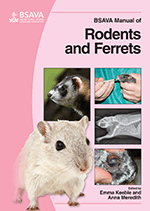
Full text loading...

Urogenital disease is not uncommon in the ferret, with degenerative, infectious (bacterial, viral), metabolic, nutritional, neoplastic, anatomical and toxic causes all being represented. Primary reproductive tract disease is uncommon in countries where ferrets are routinely surgically neutered before the age of 1 year; however, as these ferrets age they are more predisposed to adrenal disease and its secondary hormonal influence on prostatic and remaining uterine tissue. Intact and periparturient jills have their own subset of disease conditions and knowledge of the pathophysiology associated with conditions such as pregnancy toxaemia, mastitis and pyometra will aid in their prevention and diagnosis. Early recognition of neonatal disease and knowledge of the normal characteristics of newborn kits will allow the veterinary surgeon to improve kit survival. This chapter looks into Reproductive disease and Urinary tract disease.
Ferrets: urogenital and reproductive system disorders, Page 1 of 1
< Previous page | Next page > /docserver/preview/fulltext/10.22233/9781905319565/9781905319565.27-1.gif

Full text loading...











